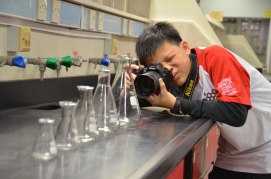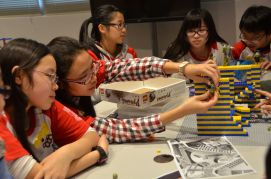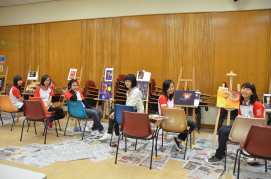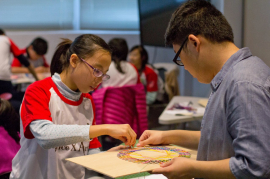Media
HKU Faculty of Science Hands-on Programme
Visualizing Science via Interactive Art for Secondary School Students
27 Jan 2013
Science and art, intertwined yet pole apart, were the twin dynamic components in the cultural development of any civilizations. However, people often merely consider their polarity, which leads to the partitioning of curiosity, inquiry and knowledge into specialized compartments. As the forerunner of science education in Hong Kong, the Faculty of Science of the University of Hong Kong took the initiative to create a science and art crossover in the community. We organized a one-day programme on Science and Art Crossover Project to junior secondary school students in HKU on January 26, 2013 Saturday. While offering fun-filled science and engineering talks and hands-on science and art crossover workshops, we promoted science literacy and enhanced students’ appreciation of science in an artistic sense. We also provided a good opportunity for students to demonstrate their creativity, immerse their personal interest and identify where their strengths lie. We hope the students and general public can experience the synergy of science and art together instead of appreciating them separately.
The one-day Programme was well received, with around 100 junior secondary school students (F.1 to F.3 students of local secondary schools and Year 7 to Year 9 students of international schools) participating the talks and workshops. Below please find a summary of the programme highlights:
Talks
• Geometry and Origami
• Lotus Effect
• Science of Painting
Workshops
• Capture the Moment in a Laboratory
• Unwrapping Science in Art
o Platonic and Archimedean solids + String Arts
o Painting on Canvas
• Create the Impossibility by LEGO® - Learn Escher, Go On!
Professor Chan Lung Sang, Chairman of the Board of the Faculty of Science, and Professor Paul Y. S. Cheung, Associate Director of Knowledge Exchange, kicked off the programme with two energetic and inspiring speeches to welcome students who came from all parts of Hong Kong. After a series of group photos with wearing the programme T-shirt, the three morning lectures officially began. Dr. Patrick T. W. Ng from the Department of Mathematics began the first lecture on “Geometry and Origami”. He decoded angle trisection, one of the three classical problems of antiquity using origami. Participants were given a piece of origami paper to trisect a 90o angle into three 30o angles. The second lecture was “Lotus Effect” delivered by Dr. Tony S. P. Feng from the Department of Mechanical Engineering. Lotus, a symbol of pure in Chinese culture, reveals its untainted secret to scientists and engineers in addition to its divine beauty. Dr. Feng explained to the participants that a water droplet will always form a bead on lotus leaves because they are rough at the nanoscale. 10 nanometers is a thousandth of a human hair width. This roughness creates a water-hating superhydrophobic phenomenon, which has been used as a water repellent coating. To wrap up the morning lectures, Dr. Aleksandra B. Djurišić from the Department of Physics demonstrated how “science” was used in painting. Using many famous paintings, she discussed how chemical compositions of paints evolved from natural organic substance to synthetic substance over time and how optics such as reflection and refraction affected the depth of an image. The participants learned more about the interconnectedness of science and art from these interactive and engaging lectures. After the lectures, Dr. Benny C. H. Ng, the director of the Science and Art Crossover Project, briefly explained to the participants what they would learn in each of the 4 workshops that afternoon. Once again, they were very excited and the energy from them was contagious.
After lunch, the HKU student ambassador led participants to one of the four afternoon workshops: “Capture the Moment in a Laboratory”, “Unwrapping Science in Art: Platonic and Archimedean solids + String Arts “, “Unwrapping Science in Art: Painting on Canvas”, and “Create the Impossibility by LEGO® - Learn Escher, Go On!”. Mr. Kevin K. W. Lau from the Journalism and Media Studies Centre led the “Capture the Moment in a Laboratory” workshop. He taught composition and lighting theory to the participants and took them to a laboratory to put the theory into practice. Mr. Pak Leong Cheung, a post-graduate student from the Department of Mathematics, instructed how to make Platonic solids and Archimedean solids using colorful plastic sheets. Then, he guided them how to use coloured thread to create different geometric patterns (curve stitching). Dr. Nam Kiu Tsing, an Associate Dean of Teaching & Learning of the Faculty of Science, along with Mr. Mike Chan, a HKU alumnus, taught the painting workshop. Participants used their paintbrushes to portray famous scientists or express their views on scientific developments. Last but not least, our LEGO® experts assisted our participants to bring M. C. Escher’s impossible 3D constructions live using LEGO®. M. C. Escher, a Dutch graphic artist, applied many mathematical elements such as impossible construction, symmetry, polyhedral, and tessellation into his paintings.
After the hands-on workshop, participants returned to the centennial campus for the closing ceremony and one last activity. They were given a palm-sized t-shirt to reflect their experience today, which will be displayed in exhibition. When they saw themselves and their artwork displayed on the screen, they, despite a full-day event, rejuvenated once again and filled the room with cheers. Dr. Benny Ng believed that this programme was very successful from many sponsors’ supports and participants’ reaction. He said, “This is the first program ever by Faculty of Science to focus on junior secondary school students. As a scientist and educator in Hong Kong, he hopes to bring science out of the traditional laboratory setting. The Science and Art Crossover Project allows students to use art as a medium to learn science and let the general public view science from an aesthetic perspective through upcoming exhibitions. To me, that’s a meaningful knowledge exchange not only between science and art but also between the university and the community in Hong Kong.” Many students expressed their interests in participating in a similar event next year.
Students’ artworks completed in the programme will be showcased at the Science & Art Crossover Exhibition at various locations such as secondary schools, museums, and shopping malls for the following 6 months. The set-up of such exhibitions will enhance the public interest in art and scientific literacy.
For event photos and sharing by students, please visit: http://www.scifac.hku.hk/news/media?page=1
For press enquiry, please contact Ms Cindy Chan, Communication Manager of HKU Faculty of Science at 2241 5286 / 6703 0212 or email: cindycst@hku.hk ; or Dr Benny Ng, Programme Director of the Science and Art Crossover Project by email at ngbenny@hku.hk .




